- Table of Content
- 1.Space for Clim...
- 2.Review of sola...
- 3.Review of geom...
- 4.The SIDC space...
- 5.PROBA2 Observa...
- 6.The Internatio...
- 7.Noticeable Sol...
- 8.Geomagnetic Ob...
- 9.Action!
2. Review of solar activity
3. Review of geomagnetic activity
4. The SIDC space weather briefing
5. PROBA2 Observations (15 Aug 2022 - 21 Aug 2022)
6. The International Sunspot Number by SILSO
7. Noticeable Solar Events (15 Aug 2022 - 21 Aug 2022)
8. Geomagnetic Observations at Dourbes (15 Aug 2022 - 21 Aug 2022)
9. Action!
Space for Climate - Open Doors
The Space Pole opens its doors on September 24-25 - step onto its grounds in Uccle, Belgium.
A weekend of fun and games for the youngest, scientific discovery for the whole family and direct interaction with the scientists themselves.
Whether you come to see the telescopes or to learn about weather, climate, aurora or the planets of the solar system, we have it all lined up for you. See you then!
The STCE will presents the play 'Alarm in the space weather room' and the talks 'Northern lights: heavenly science' - 'Solar Storm heading Earth'.
September 24-25, 2022, 10 a.m.- 6 p.m.
Ringlaan 3 Avenue Circulaire, 1180 Brussels
Free entrance
Check: https://spacepole.be/en/open-days
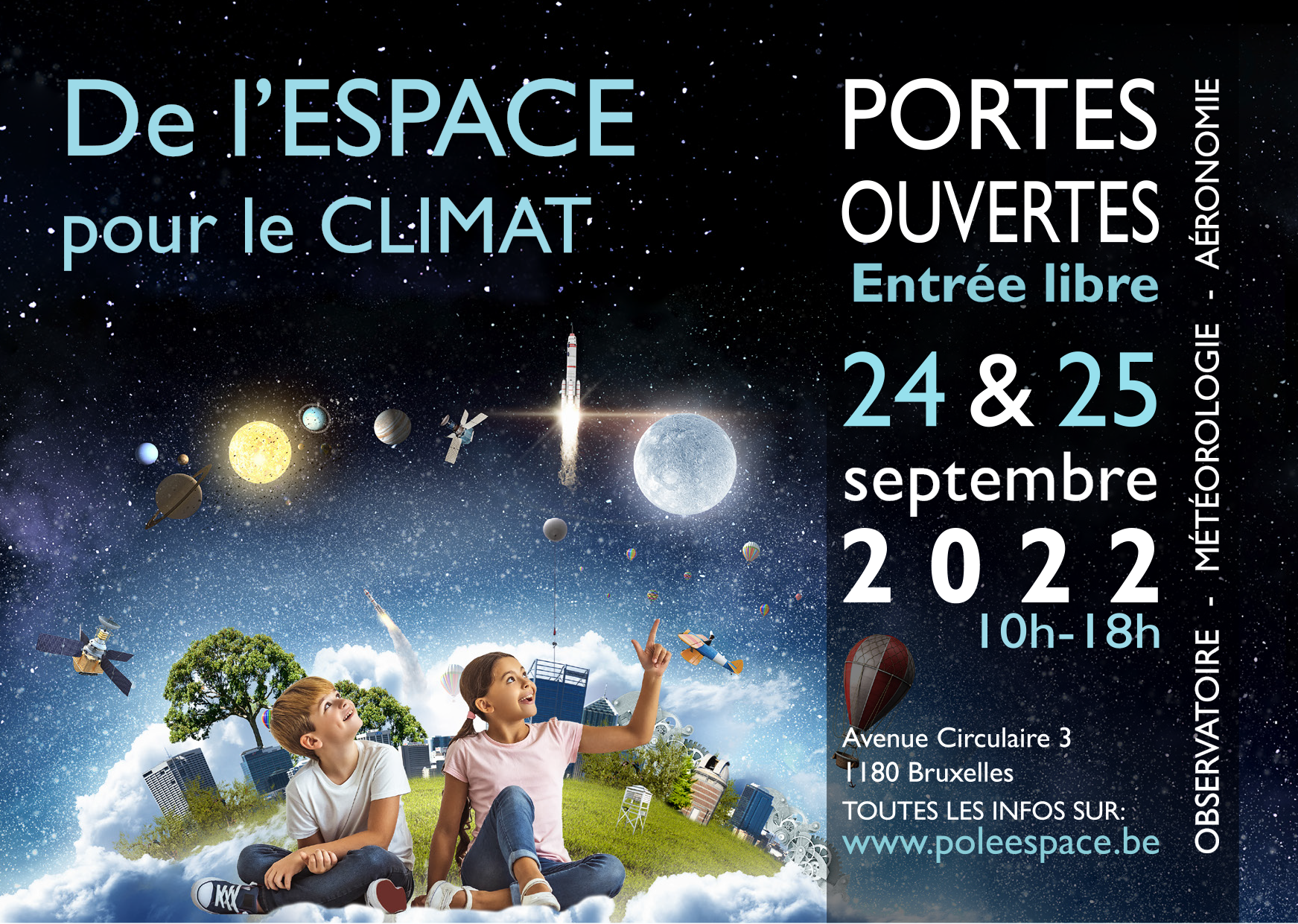
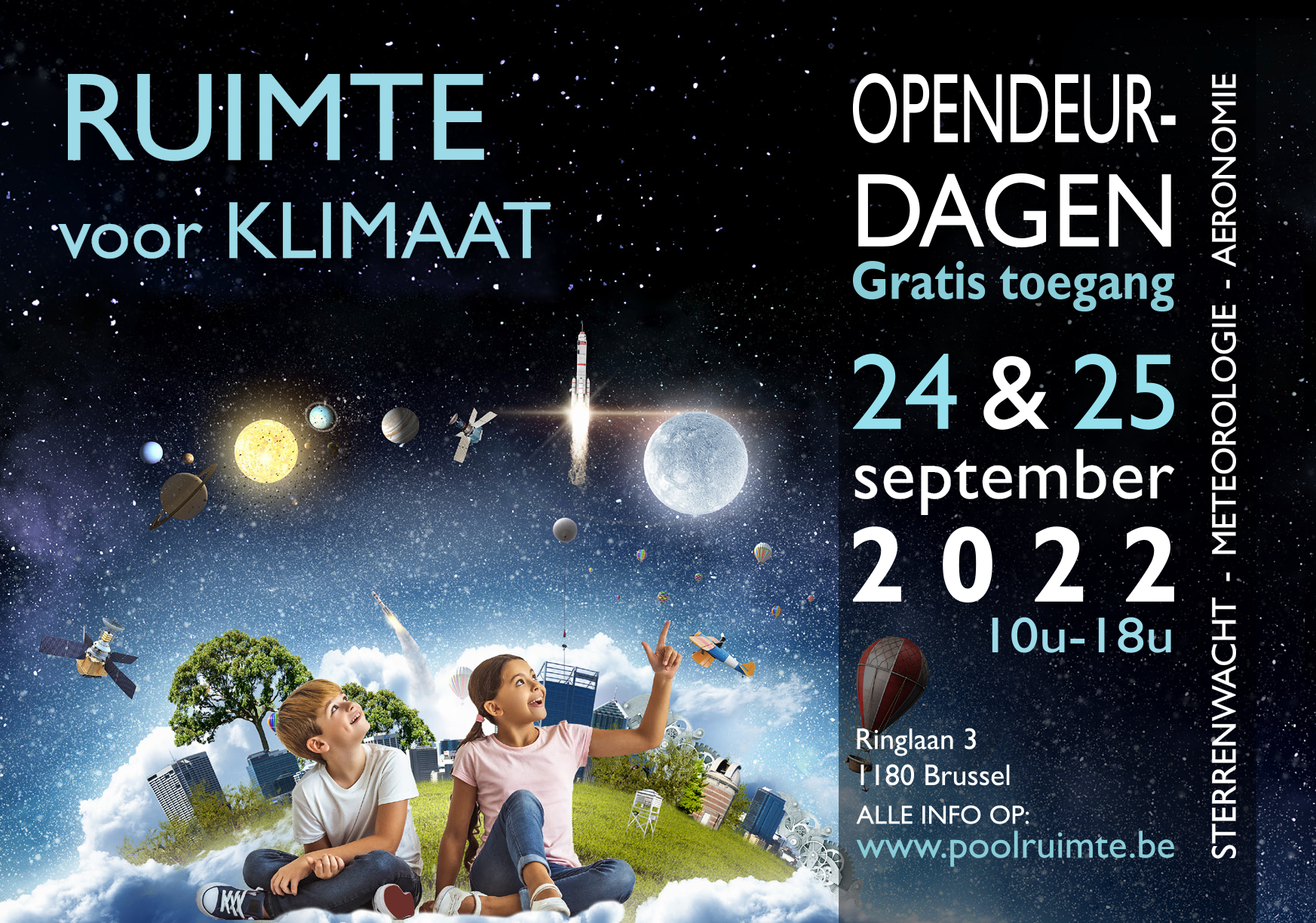
Review of solar activity
Flares
Solar flaring activity increased to moderate levels between August 15 and August 19, with 11 M-class flares recorded, the largest of which was an M5 flare on August 16, peaking at 07:58 UT. All the M-flares and a large number of C-class flares were associated with NOAA AR 3078, which began to develop quickly during the first half of the week. During the week, there were eight other active regions on the disk but these were mostly simple regions that produced only C-class flares. Towards the end of the week, NOAA AR 3078 began to decay gradually and was approaching the west solar limb, resulting in a return to low solar flaring activity on August 20 and 21.
Solar wind disturbances
There were multiple coronal mass ejections (CMEs) observed over the course of the week, many of which were related to the flaring activity around NOAA AR3078. A CME, associated with a filament eruption, first seen in LASCO C2 on August 15 05:00UT to the south-west was predicted to have a possibility to arrive at Earth on August 18. A C5.9 flare had an associated CME, first seen in LASCO/C2 on august 16 02:12UT, and was predicted to have a glancing blow at Earth on August 19. A CME observed on August 17 at 14:36 UT in LASCO C2, which was associated with an M2 flare, was also predicted to have an Earth directed component with an arrival time of August 20. On August 15, a CME was observed to the south west in LASCO/C2 from 11:00 UT, associated with a filament eruption following an impulsive M1.3 flare. A glancing blow at Earth was predicted on August 21. An M1.6 flare occurred on August 19 04:00 UT that had an associated Type II radio emission and a CME, first seen in LASCO C2 at 04:49, which was predicted to influence Earth on August 22.
At the start of the week, on August 15, a large trans-equatorial negative polarity coronal hole was transiting the central meridian. On August 17 and 18, two small negative polarity coronal holes in the southern hemisphere began to cross the central meridian.
Solar Energetic Particles
The greater than 10 MeV proton flux was at nominal levels throughout the week.
The greater than 2 MeV electron flux was above the 1000 pfu threshold between August 14 and August 17. After a short period with nominal values on August 18, the flux began to increase again on August 19 and continued to fluctuate near the 1000 pfu threshold for the rest of the week.
The 24h electron fluence was at moderate levels on between August 14 and August 18, and reduced to nominal to moderate levels for the remainder of the week.
Review of geomagnetic activity
Solar Wind Conditions near Earth (L1)
The Earth was under the waning influence of a positive polarity high-speed stream at the start of the week, with a decreasing solar wind speed trend and values around 400 km/s. The orientation of the magnetic field changed from the positive to the negative sector (field towards from the Sun) on August 16.
A shock was observed in the solar wind parameters on 17 August at 02:14UT, which was likely the arrival of a CME reported in the previous week from August 14. The value of the total magnetic field increased from 9 to 16nT, the solar wind speed from 392 to 424 km/s and the density from 7 to 16 ppcc. Bz was variable but with an extended period of negative Bz in the afternoon of August 17, with a minimum Bz of -17nT.
The solar wind speed gradually increased over the next days, also in response to the expected high-speed stream from the negative polarity coronal hole, reaching values over 600 km/s.
A second shock was observed on August 19 at 17:02 UT, where the value of the total magnetic field increased from 8 to 12nT and the solar wind speed from 562 to 640 km/s. The solar wind speed then increased gradually to over 680 km/s on August 19.
A third weak shock signature was observed in the solar wind speed at about 17:24 UT August 20.
The solar wind speed then remained steady around 560 km/s on August 21.
Geomagnetic impact
Geomagnetic conditions were quiet from August 14 to August 16 and reached moderate storm levels (NOAA Kp 6) between 21:00 UT August 17 and 00:00 August 18, after the arrival of the shock and ICME on August 17. The geomagnetic conditions for the rest of the week were mostly at unsettled to active levels with four further minor storm intervals recorded on August 18 and 19, in response to the continued fast solar wind and the further transient features described.
The SIDC space weather briefing
The Space Weather Briefing presented by the forecaster on duty from August 14 to 21. It reflects in images and graphs what is written in the Solar and Geomagnetic Activity report: https://www.stce.be/briefings/20220822_SWbriefing.pdf
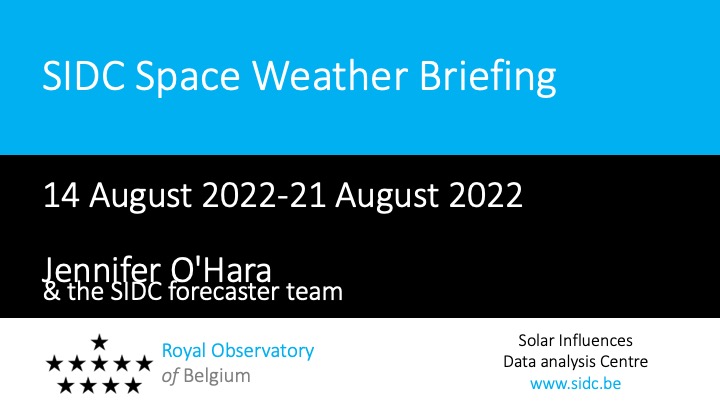
If you need to access the movies, contact us: stce_coordination at stce.be
PROBA2 Observations (15 Aug 2022 - 21 Aug 2022)
Solar Activity
Solar flare activity fluctuated from very low to moderate during the week.
In order to view the activity of this week in more detail, we suggest to go to the following website from which all the daily (normal and difference) movies can be accessed: https://proba2.oma.be/ssa
This page also lists the recorded flaring events.
A weekly overview movie (SWAP week 647) can be found here: https://proba2.sidc.be/swap/data/mpg/movies/weekly_movies/weekly_movie_2022_08_15.mp4.
Details about some of this week's events can be found further below.
If any of the linked movies are unavailable they can be found in the P2SC movie repository here: https://proba2.oma.be/swap/data/mpg/movies/.
Monday Aug 15
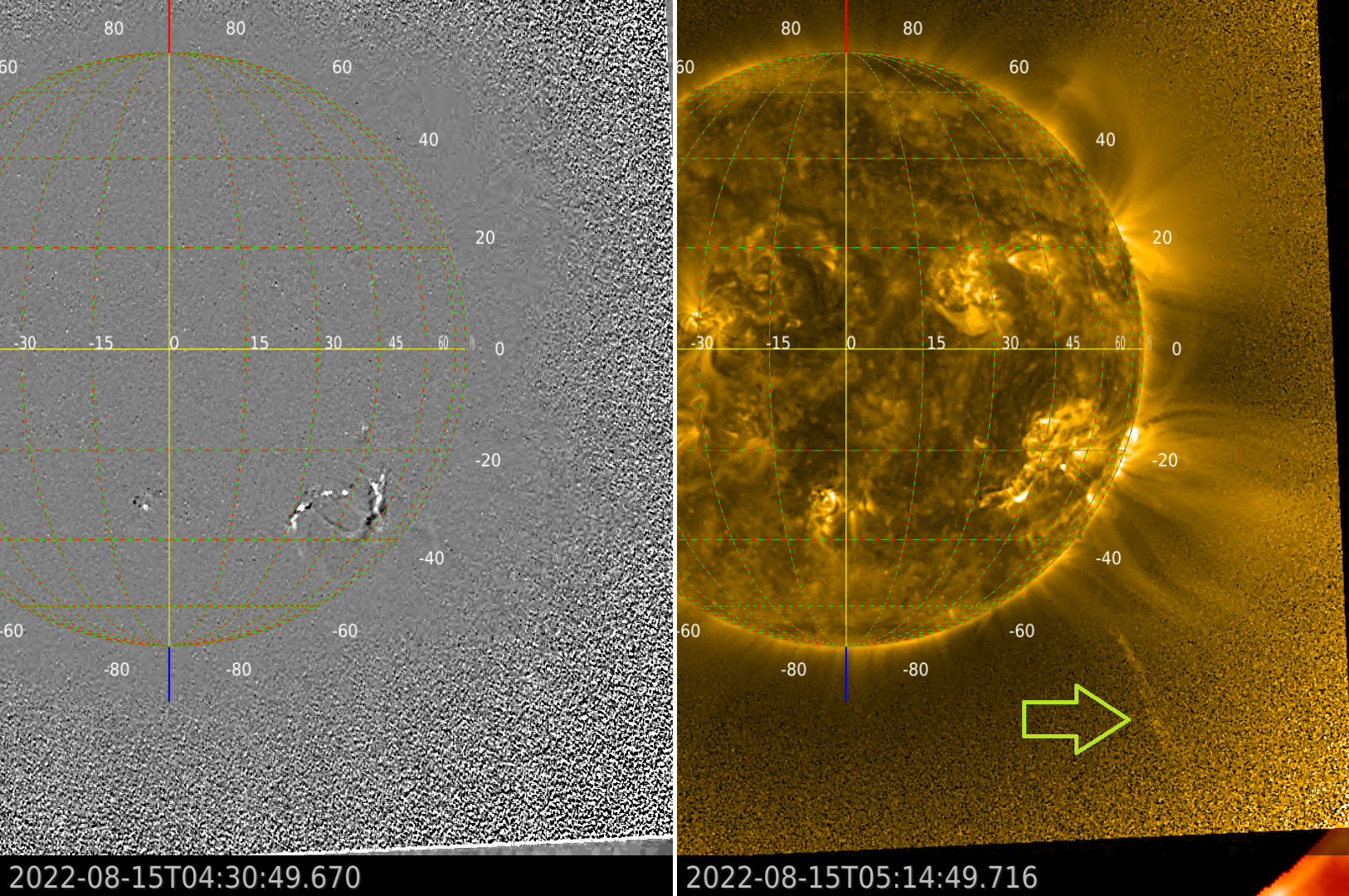
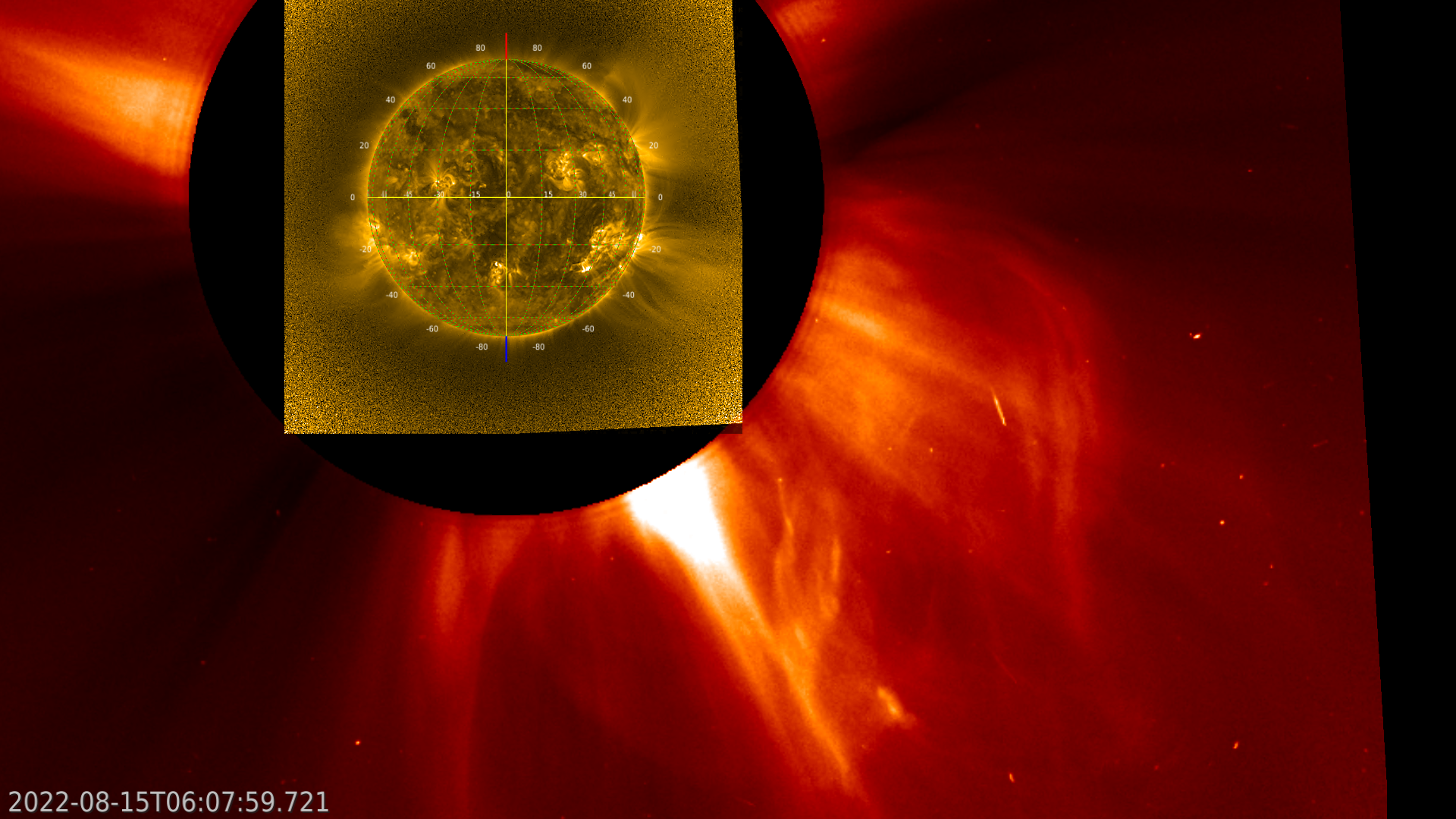
A large filament can be seen erupting in the top SWAP images on 2022-Aug-15. The running difference image in the left panel shows the origin of the filament, and the right panel contains an image of the erupting prominence material which can be tracked up to 2Rs (indicated by the green arrow). The bottom panel is a composite PROBA2/SWAP and SOHO/LASCO-C2 image, showing the CME associated with the filament eruption, at approximately 06:07 UT on the same day.
Find a SWAP movie of the event here: https://proba2.sidc.be/swap/movies/20220815_swap_movie.mp4.
Tuesday Aug 16
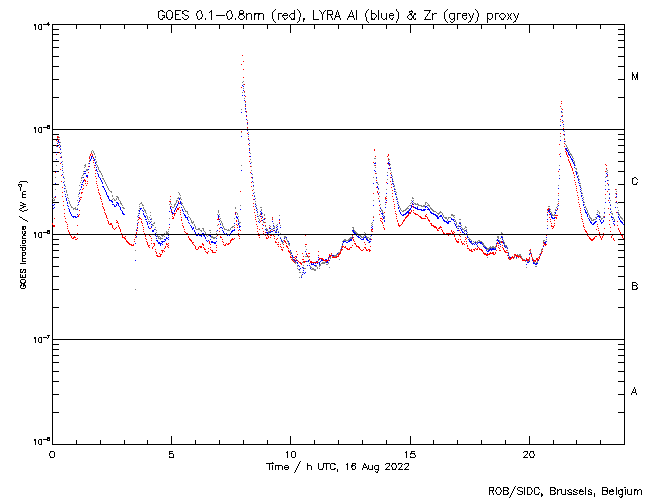
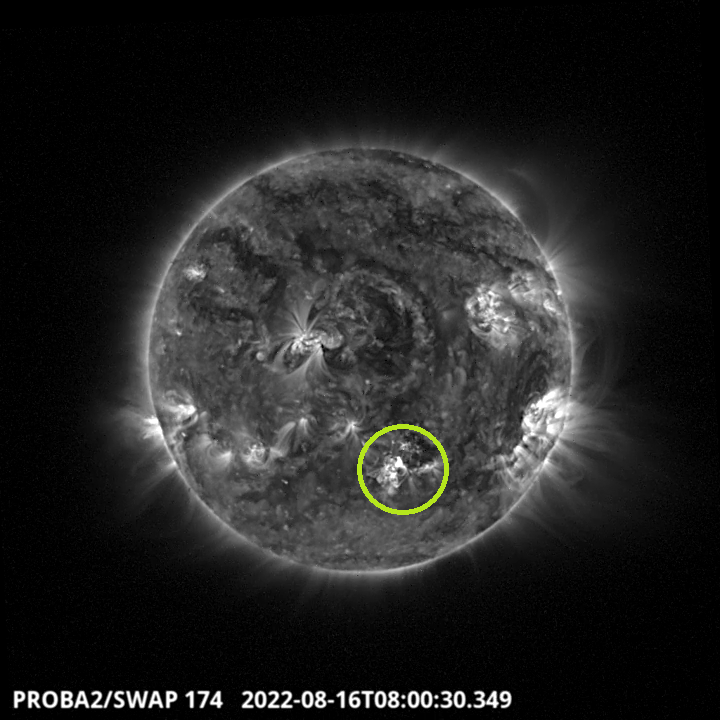
The largest flare of the week, an M5.0 flare, was observed by SWAP and LYRA. The flare was associated with NOAA AR3078, which was the most active this week and was located at S24W19 on 2022-Aug-16, as encircled in the SWAP image above taken at 08:00 UT.
Find a SWAP movie of the event here: https://proba2.sidc.be/swap/movies/20220816_swap_movie.mp4
The International Sunspot Number by SILSO
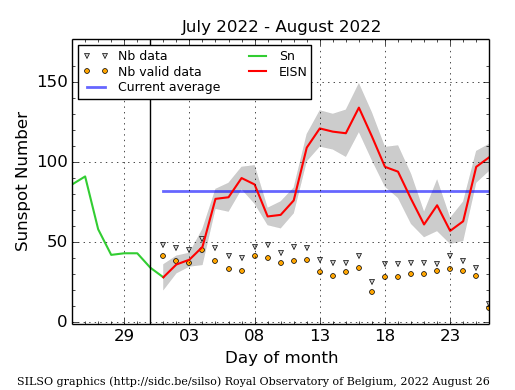
The daily Estimated International Sunspot Number (EISN, red curve with shaded error) derived by a simplified method from real-time data from the worldwide SILSO network. It extends the official Sunspot Number from the full processing of the preceding month (green line), a few days more than one solar rotation. The horizontal blue line shows the current monthly average. The yellow dots give the number of stations that provided valid data. Valid data are used to calculate the EISN. The triangle gives the number of stations providing data. When a triangle and a yellow dot coincide, it means that all the data is used to calculate the EISN of that day.
Noticeable Solar Events (15 Aug 2022 - 21 Aug 2022)
| DAY | BEGIN | MAX | END | LOC | XRAY | OP | 10CM | TYPE | Cat | NOAA |
| 15 | 1427 | 1436 | 1442 | M1.0 | III/2 | |||||
| 15 | 1640 | 1654 | 1658 | S23W1 | M2.7 | 1N | III/2 | 10 | 3078 | |
| 15 | 1727 | 1735 | 1742 | S10W49 | M0.9 | 1F | 3079 | |||
| 15 | 2147 | 2153 | 2158 | S22W3 | M1.1 | SN | III/3 | 10 | 3078 | |
| 16 | 0752 | 0758 | 0805 | M5.0 | 130 | III/1CTM/1 | 10 | 3078 | ||
| 16 | 2110 | 2121 | 2128 | M1.8 | 10 | 3078 | ||||
| 17 | 1326 | 1345 | 1350 | S24W26 | M2.0 | 1N | III/1 | 10 | 3078 | |
| 17 | 1428 | 1452 | 1510 | M1.0 | VI/2III/2 | 10 | 3078 | |||
| 18 | 1000 | 1009 | 1013 | S23W38 | M1.3 | 1N | III/1 | 10 | 3078 | |
| 18 | 1037 | 1055 | 1113 | S24W51 | M1.5 | SF | IV/1II/1 | 10 | 3078 | |
| 18 | 1401 | 1413 | 1418 | S25W37 | M1.3 | 1F | 10 | 3078 | ||
| 19 | 0414 | 0444 | 0518 | S28W49 | M1.6 | SN | 150 | VI/3II/2IV/1III/2 | 10 | 3078 |
| LOC: approximate heliographic location | TYPE: radio burst type |
| XRAY: X-ray flare class | Cat: Catania sunspot group number |
| OP: optical flare class | NOAA: NOAA active region number |
| 10CM: peak 10 cm radio flux |
Action!
Check out our activity calendar: activities and encounters with the Sun-Space-Earth system and Space Weather as the main theme. We provide occasions to get submerged in our world through educational, informative and instructive activities.
If you want your event in our calendar, contact us: stce_coordination at stce.be
* August 31, Webinar: Solar Flares and Space Weather, ISWI
* September 24-25 Space Pole Open Days, Brussels, Belgium
* October 11, Webinar: Putting the FAIR principles into practice: the journey of a GNSS data repository, GNSS@Royal Observatory of Belgium
* October 24-28, 18th European Space Weather Week, Zagreb, Croatia
* November 21-23, Space Weather Introductory Course - onsite, by the STCE, Brussels, Belgium - fully booked
* December 5, 6, 8, 9, Space Weather Introductory Course - online, by the STCE, zoom - fully bookes
Check: https://www.stce.be/calendar

